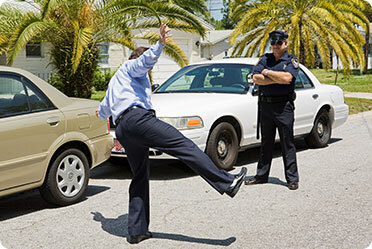
The National Highway Traffic Safety Administration (NHTSA) has researched and determined that 3 different physical tests they’ve developed can accurately determine if a driver is impaired due to alcohol and/or drugs. Once the tests were determined to ‘work’, an official program was established to train police to properly give these tests to motorists suspected of DWI / DUI. Unfortunately, testing by various agencies has determined that FSTs (Field Sobriety Tests) are inherently flawed. The information below explains the different tests currently endorsed by NHTSA and the shortcomings of the methodology..
The Horizontal Gaze Nystagmus
The horizontal gaze nystagmus (HGN) test involves the motion of the eyes. According to the NHTSA, when intoxicated people move their eyes from side to side, at the extremes of their vision, their eyes will involuntarily jerk. This involuntary jerking is known as a nystagmus. The HGN is a common test that is often shown partly on TV and movies when an officer holds a pen or finger in front of a driver’s eyes and tells the person to follow his/her finger or pen while keeping their head steady. The officer is looking to see if their eyes jerk at the left and right or top and bottom extremes of the test.
The Walk And Turn Test
As the name implies, this test requires the driver to walk a certain distance in a line, turn upon a single foot, and return to the starting point. The defendant is instructed to walk for only nine steps forward before turning around and returning. The officer is monitoring the driver for several scoring factors, such as proper balance, placement of the toe to the heel, and proper number of steps.
One Leg Stand
The driver, once they’re taken out of their car is asked by the cop to stand with their hands at their sides and keep feet together. The person is then told to raise one foot 6 inches above the ground and begin to count. (good luck balancing while you’re nervous and on one foot!) The officer then times the person for 30-60 seconds and then allows them to put their foot down, all the while watching to see if they lose their balance, flail their arms, hop or put their foot down before the end of the count.
The one leg stand and the walk / turn test, are designed to evaluate whether a person can divide their attention between a simple mental task (like counting from 1 to 100) and a simple physical test (like walking). Police believe that a sober person shouldn’t have any problem completing these tests, but you have to realize that the fear of being pulled over coupled with nighttime or uneven road surfaces can easily cause people to ‘fail’.
Problems With Field Sobriety Tests (FSTs)
Many people mistakenly believe that any of the field sobriety tests are simple for anyone that hasn’t been drinking or using drugs. However, there are a number of problems with using these tests as a standard, because people are so varied in their physiology. For example, independent scientific research has found many flaws in attempting to use these tests for people of varied height, weight, and physical ability / disability.
- No base value exists for these tests, so it’s actually impossible to accurately say what is a “normal” standard of eye jerking, balance, coordination ,or otherwise is for anybody, much less an ‘average’ human. There are some people that just naturally can’t balance, but it doesn’t mean they’ve been drinking or they’re intoxicated.
- The average person is definitely highly nervous, significantly affecting any tests they’re being asked to do.
- Many medical conditions can affect someone’s balance, their eye movements and coordination, the size of their pupils, and whole lot more.
- A person’s weight and their age can dramatically impact their balance and/or coordination. People who are overweight or over 65 years old will have a lot more trouble maintaining balance, especially under stress.
- The side of the highway is not a good nor a safe place to conduct these demanding tests, as I’m sure you can tell. The noise, visual distractions, condition of the testing area, and weather conditions can negatively impact performance on FSTs.
The problem is with the information that comes from NHTSA and the federal government itself. NHTSA has studied and reviewed the conditions and methods used by law enforcement to have people perform field sobriety tests. Surprise, surprise, according to NHTSA itself, many police officers don’t adhere to the guidelines of the tests and give them incorrectly. And don’t forget the myriad situations where the tests are given correctly but the results are misinterpreted.
The federal government itself has performed independent studies on the field sobriety tests. Research says that the way a person performs on the sobriety test is not a good, true, or valuable indication of whether a person can operate a vehicle safely, so there you have it.
Leckerman Law focuses on safeguarding the
rights of individuals charged with DUI, DWI, DAI, and
other alcohol-related criminal offenses - Call Us Now For
NJ DWI (856) 429-2323 | For PA DUI (215) 496-9292